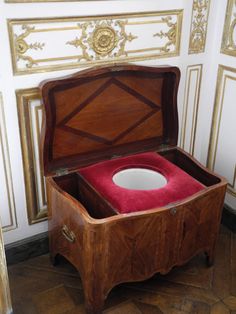 |
| A royal chamber pot from Versailles -There were no bathrooms as we would know them. Courtiers and royalty used decorative commodes in each room, while commoners simply relieved themselves in the hallways or stairwells. No one bothered to house-train the royal dogs, and servants did not consider cleaning up after them to be part of their job description. |
The palace of Versailles was once the most lavish large home in the world, the residence of the French royal family along with hundreds of their courtiers and servants. Containing half-a-million square feet, the palace compound has 700 rooms and 67 staircases. With lofty ceilings, gilded crown moldings, decorative floors, and 6000 paintings, there were also extensive servants’ quarters, kitchens, stables, and services.
Versailles was the creation of Louis XIV of France, who obsessively enlarged and enhanced his residence for more than 30 years during the 1600s. Today it’s toured by three million visitors annually, all hoping for a glimpse of the royal lifestyle.
|
| This was the royal family’s private chapel for religious services |
The Baroque aesthetic was to leave no surface unadorned. Every royal chamber has gilded paneling and crown molding; every wall has brocaded or flocked wall coverings; every ceiling is covered with allegorical paintings of Greek gods; every floor is patterned parquet or colored tiles. The hallways were done up with contrasting colors of veined marble. Everything inside, from furniture to finishes, is a visual froth of embellishments. Versailles in its day was so visually overpowering that it inspired copycat palaces all across Europe.
The chateau began as a hunting lodge built by Louis XIV’s father, fifteen miles southwest of Paris. Louis grew up during a tumultuous French civil war called the Fronde, during which he was surrounded by conspirators, had no pocket money and slept on ragged sheets. His mother even had to pawn the crown jewels. After consolidating his power as King, Louis compensated for childhood privations by building himself the most luxurious palace imaginable. He continued enlarging it throughout much of his life.
|
| The public could watch the royals from behind the golden railing (at the bottom of the photo), so that there was no privacy for the royal family, even in bed. |
The original hunting lodge was embedded within a vast series of newer buildings. Floors were added on top of existing structures, courtyards were filled in by new living spaces, wings were built, stables were constructed, staircases were built and then moved, service hallways added and then altered. The place became a complex maze containing sparkling state apartments as well as uncomfortable attic garrets tucked beneath the roof.
Ongoing construction at the palace provided job security to hundreds of masons, carpenters, plasterers, gilders, painters and landscapers. An immense support staff was maintained, consisting of cooks, valets, gardeners, grooms, hairdressers, and tailors. Vegetables and fruits to feed the masses were provided by a large potager, or kitchen garden.
But life in a palace wasn’t necessarily peaceful or enjoyable. The place was a vast hive of activity. Hundreds of courtiers lived alongside the royal family at Versailles, with their families as well. Nobles who could afford it often moved out of the crowded palace and constructed their own houses beyond the golden gates in the town of Versailles.
Versailles became a tourist destination almost from the beginning. The first visitor’s guide was published in the late 1600s. Anyone was granted entry to the grounds and the palace as long as the dress code was observed. (Hats and swords for men could be rented from the concierge at the gate.) Entry included the ability to enter into the royal apartments.
A gilded railing separated the royal half of each room from the spectators’ portion. Behind these gilded railings, a series of private doors were built into the back paneling of the royal apartments, leading to secret hallways and stairs which allowed royalty to move from one room to another while remaining hidden from public view. Years later, in 1789, Queen Marie-Antoinette temporarily escaped the revolutionary mob by slipping through one of these doors to the king’s chamber.
Marie-Antoinette (married to Louis XIV’s great-great-grandson, Louis XVI) chafed at being on display even when in her bedroom. When she gave birth to her first child at Versailles, the entire royal family and all the major state officials came to witness the event. Hordes of other inquisitive people crowded in as well, in such numbers that spectators were crushed against the furniture and walls and movement was impossible.
It’s difficult to believe today when gazing at the gleaming golden palace, but life at Versailles was actually quite dirty. There were no bathrooms as we would know them. Courtiers and royalty used decorative commodes in each room, while commoners simply relieved themselves in the hallways or stairwells. No one bothered to house-train the royal dogs, and servants did not consider cleaning up after them to be part of their job description. The constantly-altered chimneys did not draw well, so everything inside was covered with soot. The filth and disorder at Versailles during the ancient regime were noted in many records of the time.
Life at Versailles was not just foie-gras served on golden plates. In need of cleaning, requiring expensive maintenance, and with in-laws living in the wings, Versailles was not so very different from many homes today. — A previous version of this article appeared in the Bloomington, Herald-Times in 2009









